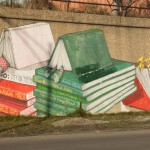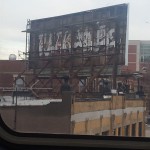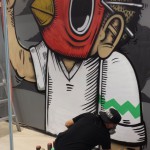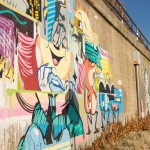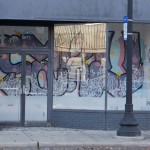By Ashley Altus
Before picking up a spray paint can for her aerosol art, Gloe One was writing her nickname on random places she might be visiting throughout Chicago. She got into graffiti because she envisioned herself painting outside on walls just like the graffiti crews did in her neighborhood.
The city has taken down her work many times, not an uncommon fate for graffiti artists. Like many in her craft she uses an artist alias.
“Even though I knew it was eventually going to be buffed, I was never really ready to accept it,” Gloe said. “I wasn’t able to understand how a brown buff was better than colorful and creative fonts.”
Gloe said her transition to “legal” graffiti – graffiti done for clients or at city-sponsored locations – was natural and logical, a move she made when her son was born in 2008.
“My son is my world and I was not willing to teeter the line,” Gloe said.
Chicago is tattooed with art on its streets. Graffiti and street art are mushrooming beyond the days of artists throwing up work at night on rooftops to catch the eyes of commuters two stories above ground on the L.
But artists tread the fine line of creating street art and graffiti legally and illegally. There is no set trajectory to where graffiti artists start making aerosol creations.
Miguel “Kane One” Aguilar said he has navigated both realms of the medium since he started “tagging” in high school – a term referring to the quick sketch of a name or phrase. Painting with permission has allowed him to hone his craftsmanship and win an audience for his typographical masterpieces that create the illusion of 3-D.
“Now when I do public street art, the intentionality and the audience has shifted to a broader community outside of different graffiti writers,” Aguilar said.
Aguilar still balances the illegal and legal worlds of graffiti. From teaching a course on the history of graffiti at the School of the Art Institute to sparking the interest of youth in this large-scale art medium with his Graffiti Institute, he pays homage to his roots by continuing to tag the city.
For graffiti veteran B-boy-b, a member of the Artistic Bombing Crew, switching tracks to produce legal graffiti wasn’t as easy.
“It was a tough transition for me,” B-boy-b said.
B-boy-b said he used to be jaded from getting caught graffiti writing in Logan Square with his East Coast style. While he was reluctant at first to transition from illegal work, he said some emerging talents in this medium don’t struggle with this issue.
“Nowadays kids don’t even worry about transitioning,” B-boy-b said. “They just start off with permission which is very odd to me. It’s not a correct cycle of graffiti life, and then all of a sudden you’re in a gallery, but you’ve never painted illegally in your life.”
Oliver Hild, the founder of Maxwell Colette Gallery in East Village, has been blurring the distinctions between street art, fine art and graffiti for the past five years.
He believes when street art and graffiti expand into the gallery system typically reserved for fine art, it increases visibility and legitimacy in the broader art context.
“The street thing is one level of artist careers at this point and the gallery can be another level,” Hild said. “The two are no longer mutually exclusive.”
Some artists choose to showcase graffiti-inspired work at galleries to expand their audience reach. And sometimes stepping away from creating illegal installations stems from an internal conflict.
Chicago artist Anthony Lewellen was initially attracted to graffiti for the adrenaline rush and the notoriety of having his name recognized throughout the city as a teenager. But creating art illegally caught up to him.
“At some point I just had a moral conflict with doing illegal work,” Lewellen said. “It was stressful too. I tried to never ruin anything, but in the end I was still on the wrong side of the law, and that was something I just could not reconcile so I just stopped.”
Illegal graffiti can become an expensive form of expression as well. In the 2014 Chicago city budget, an amendment was introduced to increase fines and penalties for illegal graffiti. The amendment increased fines from $750 to no less than $1,500 and no more than $2,500 for a graffiti offense, according to a city press release.
As artists have different reasons why they choose to participate in illegal and legal work, the public’s reception of these art mediums have grown in legitimacy.
The city provides some opportunities for artists who do large-format street painting. The Department of Cultural Affairs and Special Events (DCASE) and alderman’s offices specify sites for outdoor mural art. DCASE recently designated areas along the 606 trail.
“On a certain level, the city does not support street art, but is more tolerate of people who are street artists than ever before,” Hild said.
Even with changing attitudes and broader audiences for this art form, the city’s role is conflicted. Chicago’s ban on the sale of spray paint remains in effect after more than 20 years since its conception.
Any art in areas not designated by the Department of Cultural Affairs and Special Events (DCASE) or by aldermen is fair game for city’s Graffiti Removal Program, according to Jennifer Martinez, the director of public affairs in the Department of Streets and Sanitation.
With an average turnaround of 72 hours for 90 percent of graffiti removal requests, not including weekends, graffiti has the potential to go down just as quick as it goes up.
But graffiti done with permission of the city shapes the views many of us have of this art genre.
“I believe it is apparent that Chicago is now catching up, and political leaders have concluded that graffiti writers are not necessarily part of the gang culture,” Gloe said.
Even with changing opinions and artists creating work with permission, Aguilar said this contemporary art genre is just getting over its infancy stage.
“It’s just taken so any generations of graffiti artists being able to value themselves and to think that it is valid,” Aguilar said.
He believes the ban on spray paint as well as the increase in fines has dwindled down interest and momentum for young people to get involved in graffiti.
“They’ll get excited for maybe the first year that they do it, but then they just kind of fade away,” Aguillar said.
Aguilar said he used to just try to get his name up as much as possible. He enjoyed pushing the limits of the resistance of putting up work successfully.
“Now the shift, the focus of newer teenagers is, how I do this art form so I get a gallery show or some sort of commercial contract with a clothing line or these weird oddball opportunities,” Aguilar said. “It’s really different.”
He said when commissioned projects and gallery shows entered the world of graffiti, it changed the type of art people put up.
“Collectively what happens is people don’t push themselves or the art form hard enough because they try to dumb it down rather than push their own boundaries for financial sustainability,” Aguilar said.
Not participating in illegal art has altered the motives of some artists.
Lewellen believes the commercial interest is one of the biggest changes to graffiti culture.
“Are there graffiti artist who have never done illegal work? said Lewellen, “And the very odd answer to that questions would be yes.”




